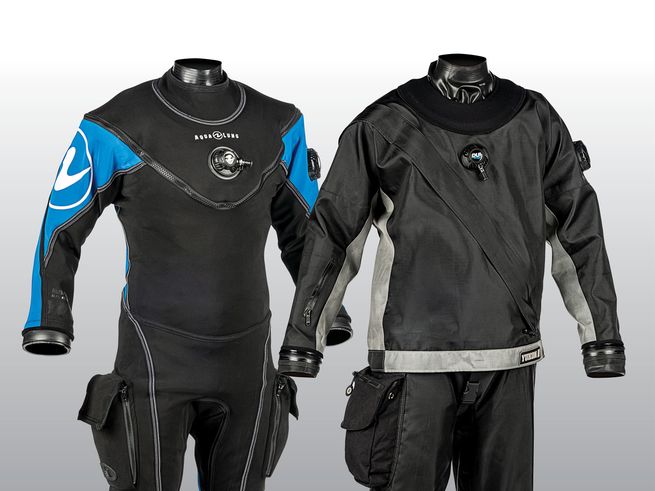Scuba Drysuits

A lot goes into choosing and maintaining your scuba drysuit. Learn how to choose the perfect drysuit and keep it for years to come.
There’s no hidden meaning here—drysuits keep scuba divers dry and allow them to remain comfortable while diving in cold water.
Unlike wetsuits, it’s not about the thickness of the drysuit that helps divers stay comfortable. Scuba drysuits use seals and zippers to keep water out, creating a layer of air around the body. This is much easier to warm up than water and allows divers to wear layers of clothes underneath to fight the cold.
Drysuit diving requires practice and training. Each suit has a valve mounted on the chest—which is a low-pressure inflator valve—and a vent mounted on the shoulder, allowing the diver to add and vent air as needed to maintain neutral buoyancy.
ScubaLab’s team of test divers evaluated new drysuits; check out thecomplete drysuit review here.
What to Consider When Choosing a Drysuit — Finding Your Perfect Fit
It’s important to evaluate a drysuit’s seals, zippers, valves and materials when choosing which drysuit is best for you. Do you prefer latex or neoprene seals? Make sure the seals are comfortable and do not restrict your movement. Some latex seals are trimmable so you can lock in a custom fit. Are the valves located in a convenient place and easy to use? Make sure the zippers are high-quality and relatively easy to use for convenient donning and doffing. Also, some drysuits feature telescoping torsos, which can make it easier to fit a range of divers. Those without this feature are less forgiving of a poor fit.
Check out the 13 categories that ScubaLab test divers evaluate whenreviewing drysuits here. This will give you a good idea of what to look for when evaluating a suit for yourself.
Read More : 5 Reasons To Buy Your Own Scuba Diving Gear
The Different Types of Drysuits
There are two main types of scuba drysuits: membrane (also called a shell or trilaminate drysuit) and neoprene. A membrane suit is often made with a trilaminate (or three-layer) design, which is lightweight, easily foldable, and without inherent buoyancy. But the material does not provide warmth on its own, requiring undergarments to do the heavy lifting. A neoprene drysuit is essentially a very thick wetsuit that is waterproof. These are heavier and more form-fitting, but also warmer on their own.
Choosing the Right Drysuit Fit
Fit is crucial when selecting your drysuit. It’s important to choose a suit that does not restrict your normal range of motion, is easy to operate and is not too tight around your neck, wrists and ankles. Another key factor to consider is the size of the drysuit’s boots if it has hard bottom boots. Start with your manufacturer’s sizing chart. Make sure you have exact measurements when ordering a drysuit and try it on for a test dive to ensure a comfortable fit.
Drysuit Accessories
Drysuit accessories are important in ensuring a warm, comfortable dive. Thick gloves are often needed to keep your hands warm. You can often connect your gloves to your suit using a pair of plastic rings and wear thermal glove liners underneath to stay dry and warm. Many drysuits come with latex or neoprene soft socks, allowing you to choose your own hard boot to wear over them. There are also special hoods designed to be worn with a drysuit’s neck seal that minimize water entry.
Proper Care and Maintenance of Your Drysuit
Before you dive, start by inspecting your drysuit’s seal for any cracks or degradation, then take a look at the zipper to make sure the teeth are not out of line. Make sure your inflator and exhaust valves are working properly and lubricate any latex seals with talc or soapy water to help get the suit on more easily.
After a dive, rinse the suit with fresh water while you have it on. If you dived in saltwater, be extra thorough to clear the suit of any salt or debris. Clean seals with soap and water and rinse the suit off. If any moisture is in the inside of the suit, turn it inside-out to dry. Lubricate your drysuit’s zippers with a manufacturer-approved wax rather than using silicone. For more on inspecting and cleaning drysuits, check out this video.
